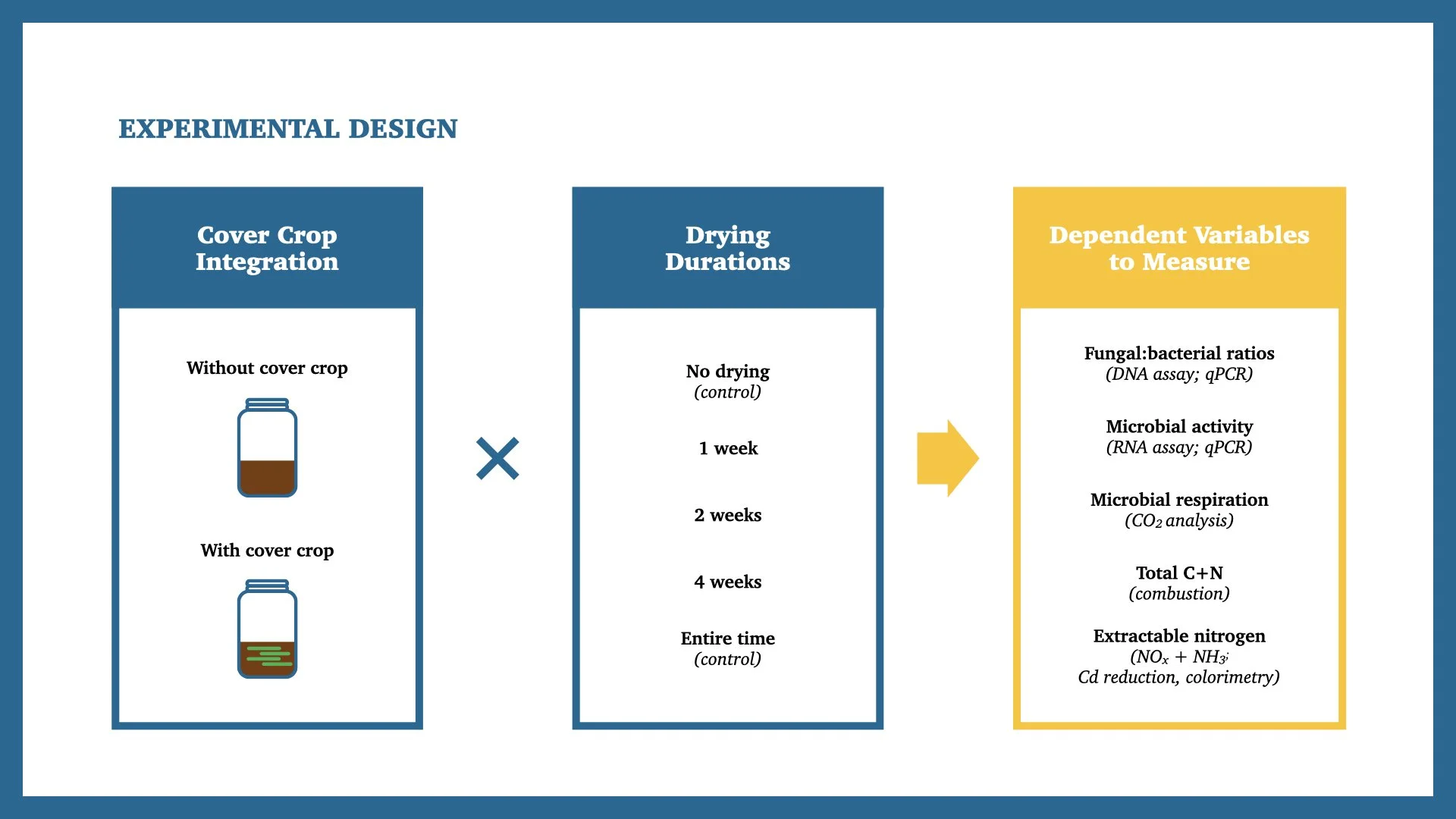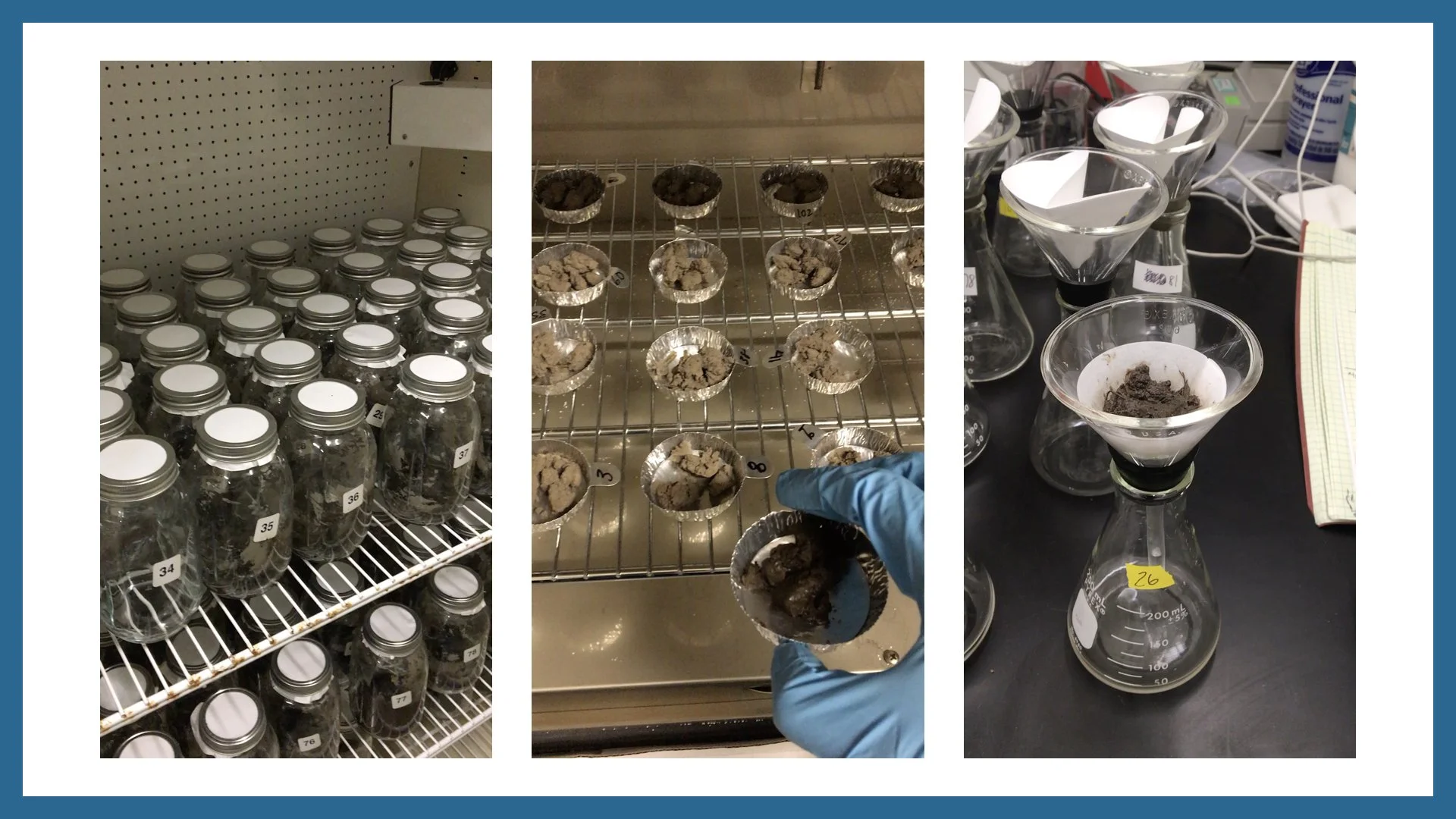Microbes Out of Water
Researching the effects of moisture stress on soil microbes at an organic farm.
Background
As we’ve seen in the past few years, anthropogenic, or human-caused, climate change destabilizes regional climates and brings about more extreme precipitation events. In California, it’s predicted that we will be seeing more of these prolonged and intense droughts interspersed with rapid, extreme rainfall in the coming years. For industries that are extremely weather and water-dependent, like agriculture, this can pose a serious risk. Already, 79% of California’s freshwater withdrawal is used for irrigation alone and these sources are increasingly stretched thin as demand is only expected to grow.
Moisture changes can affect many aspects of the soil, including its soil microbes. Soil microbes include the various fungi and bacteria that drive critical processes like decomposition and nutrient cycling. In an agricultural setting, their activities can help plants access nutrients and grow more efficiently. When environmental moisture levels change, this can impact how well they can cycle these nutrients. Previous studies have found that increased intervals between rainfall events can significantly reduce microbial activities.
Understanding how moisture stress affects soil microbes is critical due to their significant role in carbon and nitrogen cycling. In many ecosystems, nitrogen is a limiting factor for plant productivity. Most of it is tied up in dead organic matter which is subsequently decomposed by both bacteria and fungi. This breakdown of organic compounds makes nitrogen more accessible to plants and other microbes. But when production of accessible nitrogen exceeds microbial and plant demands, inorganic nitrogen can accumulate in the soil and be lost either gaseously via denitrification or volatilization via leaching as it washes out with water.
Oftentimes, conventional farms will add tons of synthetic nitrogen fertilizer to increase yields. But a lot of agricultural run off ends up in larger bodies of water, causing harmful algal blooms that then choke out other life in these so-called dead zones. Excess leaching can also result in groundwater contamination which typically occurs in areas near high intensity agriculture and cause severe human health and ecological problems.
Interestingly, too much fertilizer may even cause harm to the fields they’re applied to as excess application has actually been linked to a decrease in total soil nitrogen over the long-term. This is consistent with an IPCC report that estimates that about 50% of applied nitrogen is not taken up by crops and that nitrogen loss rates are disproportionately higher than nitrogen input rates with excess applications.
On the other hand, organic farms utilize a system called cover cropping, in which instead of letting their fields lie fallow, they grow non-cash crops (i.e. crops that will not be sold) during the off-season to restore soil health. These crops can then be mowed and disked back into the soil before cash crops are planted. This practice has many documented benefits, including adding nitrogen and organic matter back into the soil and creating better soil structure. There is also substantial evidence that planting cover crops can decrease nitrogen leaching. However, it’s still not well understood how integrating cover crop influences soil microbes affected by the more extreme precipitation regimes we’ll be seeing more of.
Thesis Focus
For my research, I’m trying to understand the intersection of all these biogeochemical factors. Primarily, how does the integration of cover crops affect soluble nitrogen loss? And how are soil microbes, specifically their community composition and activities, affected by drying and rewetting stress?
To examine these questions, I’ll be using soil from Star Route Farms in Bolinas, the oldest continuously certified organic farm in California which is also now owned by USF. At Star Route Farms, a mix of cover crops such as purple vetch and bell beans are planted in the winter and typically mowed and disked around late March. A few weeks later, after the cover crop residue has decomposed, cash crops are then planted.
I will be conducting a blinded, randomized sealed jar experiment using 950-mL mason jars stored in a controlled growth chamber. My treatment conditions encompass two independent variables: cover crop integration and drying duration with 5 replicates for each factorial combination. At each sampling point, I will measure microbial community composition in terms of fungal:bacterial ratios, microbial activity, microbial respiration, total soil carbon and nitrogen, and extractable nitrogen in both the soil itself and in simulated leachate.
Current Progress
In the spring of 2021, I conducted a trial experiment running through these procedures, measuring everything except for CO2 respiration. I am currently processing the samples from this trial run and analyzing the data while honing my protocols for the final experiment in the spring of 2022. Preliminary analyses show promising signals across different drying and cover crop treatments.
Images from spring 2021 trial experiment.
Left: Initial experimental set up with sieved and homogenized soils with and without cover crop residue in 950mL mason jars stored in a controlled growth chamber.
Middle: Dried soil samples in preparation for carbon and nitrogen elemental analyses.
Right: Set up for creating artificial leachate using funnels, filter paper, and flasks.
Implications
Overall, I believe that this research will help to clarify soil biogeochemical interactions, a very complex and still not well understood space. I hope to increase our understanding of this particular time period after cover crop integration and how it affects the state of the soil once cash crops are ready to be planted.
I hope that these findings will also be able to inform future agricultural planning and management. Especially since cover crops are a hallmark of organic farming, I think that the more we can understand how the changing climate will affect these practices moving forward, the better. Maybe farmers can use this data to make more informed decisions about the timing of their planting, watering, and fertilizer schedules to increase nitrogen efficiency.
Additionally, I also hope that this may better prepare us for the expected precipitation changes that come with the current climate crisis. Given the state of the world today, we need to substantially increase the efficiency and sustainability of our agricultural systems. I hope that this research brings us one step closer to providing stable food security for a growing population in the face of a rapidly changing climate.
Stay tuned for results! 🤞
Acknowledgements:
Dr. Naupaka Zimmerman (advisor, PI, initial believer in me, random lady wanting to do science
Dr. Calla Schmidt (committee member, EA machine wrangler)
Dr. Sevan Suni (committee member, statistics pro)
Annabelle Lenderink (head of operations at SRF, infinitely patient answerer of dumb questions by me)
Jeff Oda (lab coordinator and conjurer of everything and anything)
Matt Helm (lab coordinator and problem fixer)
Darin Chun (lab coordinator and master of SmartChem analyzer)
Craig Conforti (lab manager and safe disposer of things that scare me)
and last but not least,
Scott Alberstein (co-parent of cats, maker of coffee, and hug provider for when everything is absolutely terrible)


